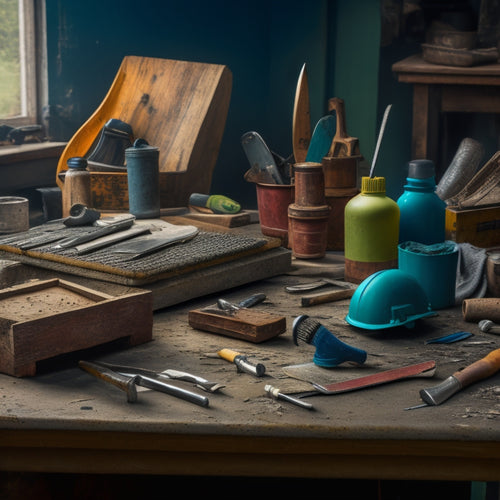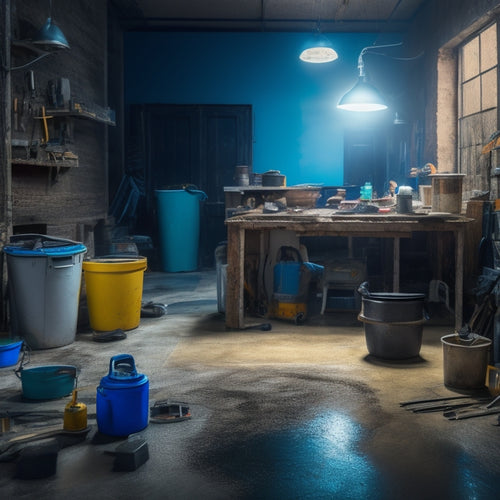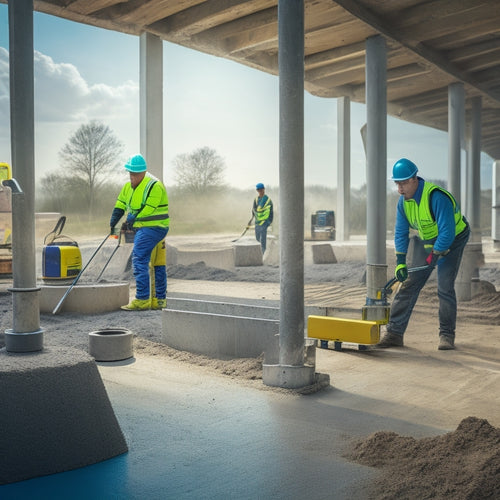
Top Tools for Grinding and Smoothening Concrete Walls
Share
When tackling concrete wall grinding and smoothening projects, you need the right tools for the job. Handheld grinders provide precise control for intricate tasks, while walk-behind grinders efficiently cover large areas. Concrete scarifiers aggressively remove coatings, and angle grinders excel in tight spaces. Dustless grinding systems prioritize safety, and smoothening tools refine surfaces for a polished finish. Concrete sanders eliminate micro-imperfections, and edger tools create crisp, clean lines. With these essential tools, you're well-equipped to achieve professional results. Now, discover how to choose the perfect tool for your specific project and reveal a flawless finish.
Key Takeaways
• Handheld grinders are ideal for intricate concrete wall grinding tasks that require precision and finesse.
• Walk-behind grinders efficiently process extensive concrete wall areas with increased power and wider grinding paths.
• Concrete scarifiers effectively remove heavy coatings and prepare surfaces for subsequent grinding and polishing.
• Smoothening tools refine concrete surfaces after initial grinding, eliminating remaining imperfections for a polished finish.
• Sanders are essential for achieving high degrees of smoothness on concrete walls, eliminating micro-imperfections for a visually appealing finish.
Handheld Grinders for Precise Control
When tackling intricate concrete wall grinding tasks that require precision and finesse, handheld grinders prove to be an invaluable asset in your arsenal. These compact power tools allow you to effortlessly navigate tight spaces and make precise cuts, making them ideal for detail-oriented work. Ergonomic designs guarantee a comfortable grip, reducing fatigue and increasing productivity.
Variable speeds enable you to tailor your grinding approach to the specific task at hand. For instance, you can adjust the speed to effectively remove old coatings, smooth out rough surfaces, or achieve a high-gloss finish. The versatility of handheld grinders also makes them suitable for a range of applications, from removing imperfections to preparing surfaces for painting or coating.
With a handheld grinder, you have complete control over the grinding process, allowing you to tackle complex tasks with confidence. Whether you're a seasoned professional or a DIY enthusiast, these tools provide the precision and flexibility you need to achieve exceptional results. By adding a handheld grinder to your toolkit, you'll be well-equipped to tackle even the most demanding concrete wall grinding projects.
Walk-Behind Grinders for Large Areas
You'll turn to walk-behind grinders for efficient processing of large concrete wall areas, where their increased power and wider grinding paths let you cover more ground quickly. When tackling extensive wall preparation projects, these machines provide the necessary muscle to get the job done.
With walk-behind grinders, you can adopt various grinding techniques to achieve the desired finish. For instance, you can use a coarse grit to aggressively remove surface imperfections or switch to a finer grit for a smoother finish.
When operating a walk-behind grinder, it's crucial to maintain a consistent pace and overlap your passes to guarantee even coverage. Additionally, be sure to adjust the grinder's speed and pressure according to the wall's condition and the grinding technique you're using.
Concrete Scarifiers for Aggressive Removal
When you need to aggressively remove heavy coatings or prepare concrete surfaces for further treatment, concrete scarifiers are the tools you'll reach for.
You'll use these machines to break up and remove old adhesives, epoxy, or other substances that are bonded to the concrete, and to create a roughened surface for better bonding.
Surface Preparation Methods
As you explore surface preparation methods for concrete walls, you'll find that concrete scarifiers prove particularly effective in aggressive surface preparation, leveraging rotating drums or flails to pulverize and remove deteriorated or damaged concrete, coatings, and mastics from walls with remarkable speed and efficiency.
These machines are designed to tackle tough surface treatment techniques, making them an essential tool in your concrete preparation strategies.
When using a scarifier, you'll notice the significant impact it has on the surface. The rotating drums or flails create a rough, textured surface that's ideal for subsequent grinding and polishing operations.
This aggressive removal method allows you to quickly strip away old coatings, mastics, and damaged concrete, revealing a fresh surface that's ready for refinishing.
Heavy-Duty Coating Removal
For heavy-duty coating removal, concrete scarifiers equipped with aggressive drums or flails are your go-to tools, capable of stripping away multiple layers of coatings, mastics, and damaged concrete in a single pass. These powerful machines are designed to tackle the toughest coating removal jobs, making them ideal for industrial, commercial, and residential applications.
When it comes to coating types, concrete scarifiers can effectively remove a wide range of materials, including:
-
Epoxy and polyurethane coatings
-
Acrylic and latex paints
-
Urethane and silicone sealants
- Mastic and adhesive residue
To achieve the best results, it's crucial to choose the right removal technique for the specific coating type and surface condition. For example, using a scarifier with a drum attachment is often more effective for removing thick, rigid coatings, while a flail attachment may be better suited for removing thinner, more flexible coatings.
Angle Grinders for Edges and Corners
You'll typically reach for an angle grinder when tackling edges and corners, where the tight spaces and curved surfaces require a more precise, controlled approach.
When working with these areas, you'll need to employ specialized angle grinder attachments designed specifically for edge grinding techniques. These attachments usually feature compact, curved, or angled heads that allow you to access and grind tight spaces with ease.
For instance, you can use a diamond cup wheel attachment to aggressively grind and smooth out rough edges, or a flap disc attachment for a more refined finish.
The key to success lies in selecting the right attachment for the job and mastering the proper edge grinding techniques. This might involve working in small, controlled sections, maintaining a consistent angle, and applying gentle to moderate pressure, depending on the surface and desired outcome.
Dustless Grinding Systems for Safety
Safety protocols take center stage with dustless grinding systems, which prioritize your well-being by minimizing airborne particles and preventing respiratory hazards.
As you work on grinding concrete walls, you're exposed to a significant amount of dust that can be harmful to your health. Dustless grinding systems are designed to mitigate this risk, ensuring a safer working environment.
Here are some key benefits of dustless grinding systems:
-
Improved dust control: These systems use vacuum technology to capture dust and debris at the source, reducing the amount of airborne particles that can cause respiratory issues.
-
Enhanced health protection: By minimizing dust exposure, you're better protected from long-term health risks associated with inhaling concrete dust.
-
Increased productivity: Dustless grinding systems allow you to work more efficiently, as you're not slowed down by dust clouds or worried about your health.
Smoothening Tools for Finishing Touches
After removing imperfections with dustless grinding systems, you're ready to refine your concrete wall's surface with smoothening tools, which deliver a polished finish that meets your project's exacting standards. These specialized tools employ advanced smoothing techniques to eliminate any remaining imperfections, ensuring a flawless finish.
When selecting smoothening tools, consider the type of finishing materials you'll be using. For instance, if you're applying a high-gloss epoxy coating, you'll want to use a tool that produces an ultra-smooth surface. In this case, a high-speed burnisher or a specialized polishing pad would be an excellent choice. These tools utilize advanced abrasives and precise engineering to create a mirror-like finish.
For less demanding applications, a simple trowel or screed may suffice. Regardless of the tool you choose, make sure it's designed for your specific project requirements.
Concrete Sanders for Smooth Finishes
When tackling concrete walls that require a high-degree of smoothness, concrete sanders prove indispensable for eliminating micro-imperfections and producing a finish that's both visually appealing and durable.
As you refine your concrete finishing techniques, you'll find that sanders are essential for achieving a high-gloss surface polish.
To get the best results, consider the following factors when selecting a concrete sander:
-
Grit level: Choose a sander with adjustable grit levels to tackle varying degrees of roughness, from coarse to fine.
-
Speed control: A variable speed control allows you to adapt to different concrete types and surface conditions.
-
Dust collection: Opt for a sander with an integrated dust collection system to minimize mess and guarantee a cleaner work environment.
Edger Tools for Perfect Borders
As you achieve that flawless, high-gloss polish on your concrete walls with sanders, you'll need to turn your attention to edger tools to define perfect borders and create a seamless connection where the wall meets the floor or ceiling.
Edger tools are specifically designed to tackle those hard-to-reach areas, allowing you to achieve crisp, clean lines and a professional-looking finish.
To master edger techniques, start by selecting the right edger tool for your project. There are two main types: electric edgers and manual edgers. Electric edgers are ideal for larger projects, while manual edgers provide more control and precision for smaller areas.
When it comes to border aesthetics, the key is to create a seamless transition between the wall and adjacent surfaces. Use your edger tool to feather the concrete, blending it smoothly into the surrounding area.
Frequently Asked Questions
How Often Should I Change the Grinding Wheel or Sandpaper?
You should change the grinding wheel every 1-3 months, depending on usage and concrete type, and swap sandpaper every 1-5 uses, considering grit selection and wheel longevity to maintain peak performance.
Can I Use a Grinder on Newly Poured Concrete Walls?
You shouldn't use a grinder on newly poured concrete walls until they've undergone sufficient concrete curing, typically 28 days. Then, choose the right grinder type, such as a walk-behind or handheld, to avoid damaging the surface.
What Safety Gear Is Necessary for Operating Grinding Tools?
As you step into the grinding zone, remember that safety is your shield. You'll need to don the full armor of grinding tool safety, including protective gear like gloves, safety glasses, and a dust mask to safeguard your health.
How Do I Prevent Dust From Spreading During Grinding?
When grinding, you'll need to implement dust control methods to prevent spreading. Create effective containment by sealing off the area, using a vacuum with a HEPA filter, and wearing a dust mask to minimize airborne particles.
Can I Rent Grinding Tools Instead of Buying Them?
As you're already taking steps to minimize dust, you're probably wondering if renting grinding tools is a cost-effective solution. Coincidentally, renting offers several advantages, including access to a wide range of tool availability without the hefty upfront cost.
Conclusion
You've made it to the final stage of concrete wall grinding and smoothening. The theory is that a well-finished concrete wall is only as good as the tools used to create it.
And we've just proven that theory true. With the right tools, like handheld grinders, walk-behind grinders, and concrete scarifiers, you can achieve a smooth, even finish that's both durable and aesthetically pleasing.
Now, put these top tools to work and take your concrete walls to the next level.
Related Posts
-

Must-Have Handheld Tools for Concrete Repair
When tackling a concrete repair project, it is crucial to have the right handheld tools to achieve a professional fin...
-

Essential Tools for Epoxy Concrete Floor Repair
You'll need a thorough arsenal of specialized tools to guarantee a successful epoxy concrete floor repair. Floor prep...
-

What Tools Ensure Precise Concrete Leveling Results
You need a range of specialized tools to achieve precise concrete leveling results. Laser leveling instruments provid...


